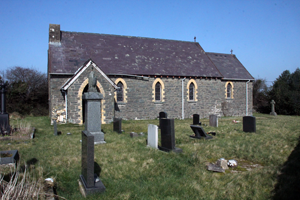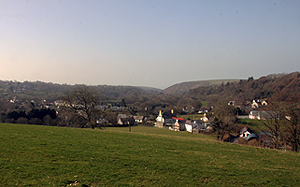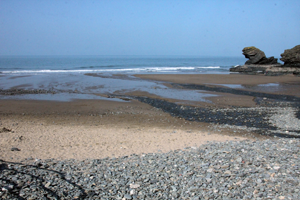The aim of this website is to provide an invaluable resource of information to all the residents of the parish of Llangrannog, which covers the villages of Pontgarreg, Blaencelyn, Pentregât and Llangrannog.
Llangrannog Community Council works to improve the quality of life in its locality. It represents electors as their first tier of government and democratic accountability, doing so through exercising a range of statutory powers and duties e.g The Council are consultees to planning applications from the Local Planning Authority, Ceredigion County Council. An annual precept is received in order to fund its work.
The Community Council is composed of 10 elected members and our local Ceredigion County Councillor. The Council employs a part time clerk to deal with the administrative work. The Community Council Chair is elected annually from amongst the serving councillors.
Community Council meetings are held on the first Monday of each month (apart from August) at Pontgarreg Memorial Hall. Dates, agendas and minutes of meetings can be found on the website. All residents of our parish are welcome to attend meetings in person or virtually, or they can contact our Community Councillors to raise legitimate concerns on their behalf. They can also raise their concerns and / or send an enquiry to the clerk via the “Contact Us” page. Correspondence is welcomed in Welsh or English.
By contacting us, we promise to keep your details safe and secure. Your personal data will not be shared or used for marketing and promotion purposes. We will only use your email to contact you directly regarding your enquiry.
Llangrannog Community Council works very hard to ensure that the voice of the community is heard, and that any concerns arisen are dealt with quickly and professionally. Our dedicated team of Councillors do their utmost to ensure that matters are dealt with fairly throughout the community.

The village of Blaencelyn can be found to the North east of Llangrannog. The stream Fothau lies on the one side of the hill and Dewi Fach on the other. The two streams meet at Glandwr in the parish of Llandisiliogogo before meeting the Dewi Fawr on their journey to the sea at Cwmtydu. It appears that Dylan Thomas refers to the River Dewi in Undermilkwood, “the singing bubbling gurgling Dewi” following his visit to the Crown Inn, Llwyndafydd.
The original name for Blaencelyn was “Banc Elusendy” (charity house hillock). It is thought that the charity house was where Blodfa is today, below the present day shop and Post Office. Catrin Lewis lived there and sold bread and kept the money in a bucket of coal, like an honesty box, outside the door. At one time there was a blacksmith in the upper end of the house on the square also named Blaencelyn. 8 of the famous Cilie family, well known for their poetry, were born here. In the lower part of Blaencelyn house there was the Green Dragon public house. Dai ‘Genesis’ was the landlord but he was illiterate. He kept a record in a Bible he kept under the counter by putting a mark in the book of what each customer owed him. After the days of the pub there was a clothes shop and a kitchenware and crockery shop here.
There was also a blacksmith at Celyn Parc where the current shop is. But as the tractor became more more familiar in agriculture there was less demand on the work of the blacksmith. St David’s Church was opened in 1895 but it closed in 2002. There is a grave there for a sailor from Norway whose body was washed up on Llangrannog beach during the First World War. During the same period a body part was also washed up and the remains were buried at St David’s cemetery. There is a long history of several sea captains in the village and local area and also a long history of agriculture with the number of farms dwindling in recent years.
On the outskirts of Blaencelyn stands Capel y Wig which celebrated 200 years in 2013. It is sad to note that 6 chapels and 1 church has closed over the last 50 years in the Llangrannog locality.

The village Ponrgarreg is situated 2miles from the A487at Pentre Gat and 2miles from Llangrannog on the B4321. Pontgarreg is named from the two stones bridge that cross the river Hawen which flows through the village and down to the sea at Llangrannog.
The valley is sheltered and has woodland which is called " allt Tredwr".In 1867 the Primary School was opened and closed in 2012 when a new area school was built in the neighbouring village of Brynhoffnant. The Memorial Hall is a community centre which is used by various organisations and was built in 1952 and refurbished with grant funding from the Lottery in 2000, there is a community playing field next to the hall with ample parking spaces. T Llew Jones the famous bard, poet and author of welsh children books lived in the village until his death in January,2009.

The Seaside village of Llangrannog was established around the church during the 6th century, although there is evidence of an early Celtic settlement at nearby Lochtyn. The village developed rapidly with the increase in fishing and associated trade. 24 ships were built near the beach and until 1914 almost all the male inhabitants were seafarers. Today, tourism is the main industry. The village is on the Maritime Heritage Coast and visitors are attracted by the sandy Blue Flag Beach and the unique village atmosphere. With beautiful surroundings and adjacent places of interest, Llangrannog can certainly offer something for everyone.
PENTRE GȂT OR CAPEL FFYNNON?
Pentre Gât is located at a Junction on the A487 between Plwmp and Brynhoffnant. For many people it is simply a place to drive past on their way to Cardigan or Aberaeron. However, this place has a lively and colourful past, mainly due to the two landmarks central to the village’s development.
Capel Ffynnon Chapel, closed in 1982, nowadays partially concealed, is to be found on the square itself. The origins of worshipping in this vicinity goes back a long while, because Daniel Rowland, Llangeitho preached at Y Gwndwn many times. The custom in those days was to move around and establish meeting houses at members’ homes, as well as worshipping at other chapels in the area. Some of those chapels who agreed to house them were Gwndwn Chapel and Pensarn Chapel.
By 1849 the membership had come to the conclusion that they needed their own place of worship, but obtaining a piece of land would be no easy task. Finally, an appropriate site was found on a 99 year lease for the yearly sum of £1. One condition insisted upon was that it be built in the Gothic style. It wasn’t architecturally a great success and certain sections of the building had to be revised and rebuilt. To accompany the chapel, a chapel house and a coach house with extensive stables were built, due to the central location of the village.
The other main landmark is the site of the former tollbooth near the car park. During the Rebecca Riots in the 1840’s every tollbooth in West Wales was under threat and this one was no exception.